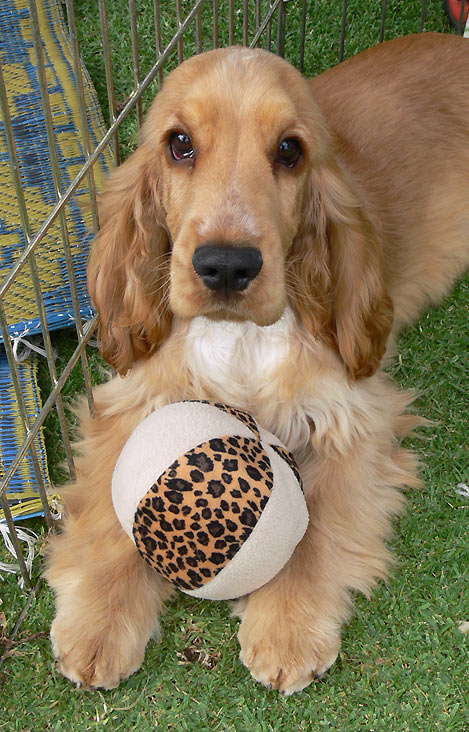Separation Anxiety
This fact sheet supplied courtesy of Sarah McMullen from Clever Creatures.
Separation anxiety is one of the most common behaviour problems in dogs. It is a very serious behaviour problem and can be very stressful for both dogs and the family members. To reduce the likelihood of a dog developing separation anxiety it is important that dogs learn to have time on their own, and enjoy that time on their own. This should start with young puppies. As much as it is nice to smother a new pup with lots of love and attention make sure they have time on their own in a secure area or play pen. During this time provide them with a variety of toys and things to chew on. It's great way to introduce toys which dispense food or Kong dog toys stuffed with treats or a meal.
 Puppies should come from reputable breeders. Although rare, I have seen dogs who are genetically prone to separation anxiety. I have also seen a number of dogs who are weaned too early who develop attachment related disorders such as separation anxiety. My first dog developed separation anxiety quite early and she had been taken from her mum at only 5 weeks of age. Dogs in pet shops are often weaned too early as are dogs from irresponsible breeders (puppy farms and some ‘back yard' breeders). A puppy should not be taken from its mum before 7 weeks of age. So if you are looking for a new pup then do the research first and do resist the temptation to buy on impulse!
Puppies should come from reputable breeders. Although rare, I have seen dogs who are genetically prone to separation anxiety. I have also seen a number of dogs who are weaned too early who develop attachment related disorders such as separation anxiety. My first dog developed separation anxiety quite early and she had been taken from her mum at only 5 weeks of age. Dogs in pet shops are often weaned too early as are dogs from irresponsible breeders (puppy farms and some ‘back yard' breeders). A puppy should not be taken from its mum before 7 weeks of age. So if you are looking for a new pup then do the research first and do resist the temptation to buy on impulse!
For a dog that already has separation anxiety it is very important that you seek help from an expert Ask your vet about who they would recommend. Your dog may need medication but it is not always required. Generally dogs should not be on medication unless they are also undergoing behaviour modification or are soon to start. Medication can help to reduce the dogs' anxiety and make it easier to learn new behaviours, and we want them to be the right behaviours! There are natural products also. For mild cases Rescue remedy or other flower essences can help as can herbal nerve tonics for pets. Room sprays such as home alone room spray or aroma calm can be used in conjunction with other products to make the environment more relaxing.
The aim when treating separation anxiety is to reduce the dog's dependence on the family or human that it lives with. This should be done slowly and carefully under expert guidance. It helps if the dog has a secure area where it feels safe. For many dogs this will be indoors when the family goes out. If the dog is destructive it will need to be a ‘sacrificial' space where it doesn't matter if the dog damages the door or similar. Just make sure the dog is safe and can't hurt itself or escape. Doggy daycare may also be an option for some dogs and may be a useful way for the dog to reduce dependence on particular family members. However I wouldn't rely on it totally. Like us dogs do need time on their own. And don't forget the importance of exercise! I don't know about you but exercise is a wonderful stress relief for me, and walking the dog benefits both human and the dog.
When the dog is to be left along ensure it has plenty to do to keep itself occupied. Food treats are very useful for this and you may wish to feed the dog's breakfast or meal when you go out. If the dog is so anxious that it won't eat then you need to speak to your vet about medication and coping strategies. If you don't already have a copy see our ebook "101 Ways to keep your dog entertained". It is very important that the dog is given mental stimulation to keep it busy and you may also find toys that encourage the dog to pull, chew or tear up could help reduce the dogs' anxiety and likelihood of targeting other items.
Training and Attention Seeking Behaviour
Dogs should not be encouraged to follow the humans around the house. Dogs who constantly seek out the humans should be ignored when they display this anxious behaviour. The behaviour may get worse before it gets better so stick with it. Dogs should also be ignored if they constantly seek out pats and attention. Making sure you call them over for pats and it should be on your terms. Incorporate training into your daily routine and not only will your dog have a clearer idea of what you want from it, but it will be more relaxed knowing it has a secure leader who can take charge.
As I mentioned earlier it is important to incorporate all strategies at once. Just trying things in dribs and drabs will not enable you to fix this problem. Seek expert advice for a tailored program to suit your family.



